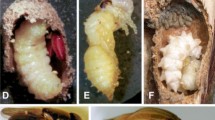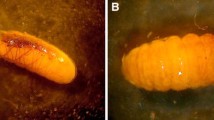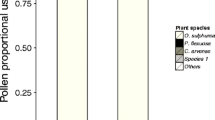Abstract
To account for differences in occurrence of social behavior in different lineages of bees, Michener (1985) hypothesized that ground nests are more easily located by parasites than are twig nests. In the former case parasites search in two dimensions, while in the latter they search in three-dimensional space. One prediction derived from this hypothesis is that ground nests will have higher rates of parasitism than twig nests. A survey of published reports on rates of cell parasitism for 92 species of nesting bees and wasps (Apoidea) shows no significant differences in mean parasitism rates between these two classes of nests. The analyses were repeated at the generic level (N=44), yielding the same pattern. These data may be biased due to phylogenetic effects. Paired comparisons (n=11 pairs) of related taxa that differ in nest site show that ground-nesting taxa more often have higher rates of parasitism than twig-nesters. The use of artificial “trap-nests” to study twig-nesters significantly enhances the success rate of parasites. This bias, as well as several other limitations, suggests that experimental studies of the host-searching capabilities of parasites and predators may be more efficacious than such comparative tests.
Similar content being viewed by others
References
Alexander, B. A. (1992). An exploratory analysis of cladistic relationships within the superfamily Apoidea, with special reference to sphecid wasps (Hymenoptera).J. Hymen. Res. 1: 26–61.
Bell, W. J. (1991).Searching Behavior: The Behavioural Ecology of Finding Resources, Chapman & Hall, London.
Bernays, E. A., and Wcislo, W. T. (1994). Sensory capabilities, information processing, and resource specialization.Q. Rev. Biol. 69: 187–204.
Bohart, G. E., and Cross, E. A. (1955). Time relationships in the nest construction and life cycle of the alkali bee.Ann. Entomol. Soc. Am. 48: 403–406.
Bohart, G. E., and MacSwain, J. W. (1940). Notes on two chrysidids parasitic on western bembicid wasps.Pan-Pacif. Entomol. 16: 92–93.
Bohart, R. M., and Menke, A. S. (1976).Sphecid Wasps of the World: A Generic Revision, University of California Press, Berkeley.
Bohart, G. E., Stephen, W. P., and Epply, R. K. (1960). The biology ofHeterostylum robustum (Diptera: Bombyliidae), a parasite of the alkali bee.Ann. Entomol. Soc. Am. 53: 425–435.
Brooks, D. R., and McLennan, D. A. (1993).Parascript: Parasites and the Language of Evolution, Smithsonian Institution Press, Washington, DC.
Brooks, R. W. (1983). Systematics and biomomics ofAnthophora: The Bomboides group and species groups of the New World (Hymenoptera: Apoidea, Anthophoridae).Univ. Calif. Publ. Entomol. 98: 1–86.
Clement, S. L. (1973). The nesting biology ofMelissodes (Eumelissodes) rustica (Say), with a description of the larva.J. Kans. Entomol. Soc. 46: 516–525.
Danks, H. V. (1971). Biology of some stem-nesting aculeate Hymenoptera.Trans. Roy. Entomol. Soc. Lond. 122: 323–399.
Eickwort, G. C. (1967). Aspects of the biology ofChilicola ashmeadi in Costa Rica (Hymenoptera: Colletidae).J. Kans. Entomol. Soc. 40: 42–73.
Eickwort, G. C., Eickwort, J. M., Gordon, J., and Eickwort, M. (1996). Solitary behavior in a high-altitude population of the social sweat beeHalictus rubicundus (Hymenoptera: Halictidae).Behav. Ecol. Sociobiol. 38: 227–233.
Evans, H. E. (1957).Studies on the Comparative Ethology of Digger Wasps of the Genus Bembix, Comstock, Ithaca, NY.
Evans, H. E. (1971). Observations on the nesting behavior of wasps of the tribe cercerini.J. Kans. Entomol. Soc. 44: 500–523.
Evans, H. E. (1978). Observations on the nests and prey of eumenid wasps (Hymenoptera, Eumenidae).Psyche 84: 255–259.
Evans, H. E., and O'Neill, K. M. (1988).The Natural History and Behavior of North American Beewolves, Cornell University Press, Ithaca, NY.
Evans, H. E., Kurczewski, F. E., and Alcock, J. (1980). Observations on the nesting behaviour of seven species ofCrabro.J. Nat. Hist. 14: 865–882.
Freeman, B. E. (1982). The comparative distribution and population dynamics in Trinidad ofSceliphron fistularium (Dahlbom) andS. asiaticum (L.) (Hymenoptera: Sphecidae).Biol. J. Linn. Soc. 17: 343–360.
Hager, B. J., and Kurczewski, F. E. 1986. Nesting behavior ofAmmophila harti (Fernald) (Hymenoptera: Sphecidae).Am. Midl. Nat. 116: 7–24.
Harvey, P. H., and Pagel, M. D. (1991).The Comparative Method in Evolutionary Biology, Oxford University Press, Oxford.
Hawkins, W. A. (1975). Nesting biology ofOsmia (Chalcosmia) georgica), (Hymenoptera: Megachilidae).J. Kans. Entomol. Soc. 48: 493–499.
Hawkins, B. A. (1994).Pattern & Process in Host-Parasitoid Interactions, Cambridge University Press, Cambridge.
Hunt, J. H. (1993). Survivorship, fecundity, and recruitment in a mud dauber wasp,Sceliphron assimile (Hymenoptera: Sphecidae).Ann. Entomol. Soc. Am. 86: 51–59.
Krombein, K. V. (1964). Natural history of Plummers Island, Maryland. XVIII. The hibiscus wasp, an abundant rarity, and its associates (Hymenoptera: Sphecidae).Proc. Biol. Soc. Wash. 77: 73–112.
Krombein, K. V. (1967).Trap-nesting Wasps and Bees: Life History, Nests, and Associates, Smithsonian Institution Press, Washington, DC.
Kurczewski, F. E., and Ginsburg, S. E. (1971). Nesting behavior ofTachytes (Tachyplena) validus.J. Kans. Entomol. Soc. 44: 113–131.
Lin, N., and Michener, C. D. (1972). Evolution of sociality in insects.Q. Rev. Biol. 47: 131–159.
Linsley, E. G. (1958). The ecology of solitary bees.Hilgardia 27: 543–599.
Linsley, E. G., and MacSwain, J. W. (1942). The parasites, predators, and inquiline associates ofAnthophora linsleyi.Am. Midl. Nat. 27: 402–417.
Linsley, E. G., and MacSwain, J. W. (1952). Notes on some effects of parasitism upon a small population ofDiadasia bituberculata (Cresson) (Hymenoptera: Anthophoridae).Pan-Pacif. Entomol. 28: 131–135.
Linsley, E. G., and MacSwain, J. W. (1956). Some observations on the nesting habits and prey ofCerceris californica Cresson (Hymenoptera, Sphecidae).Ann. Entomol. Soc. Am. 49: 71–84.
Linsley, E. G., MacSwain, J. W., and Smith, R. F. (1952). The bionomics ofDiadasia consociata Timberlake and some biological relationships of emphorine and anthophorine bees.Univ. Calif. Publ. Entomol. 9: 267–290.
Linsley, E. G., MacSwain, J. W., and Michener, C. D. (1980). Nesting biology and associates ofMelitoma.Univ. Calif. Publ. Entomol. 90: 1–45.
Martin, T. (1995). Avian life history evolution in relation to nest sites, nest predation, and food.Ecol. Monogr. 65: 101–127.
Matthews, R. W. (1991). Evolution of social behavior in sphecid wasps. In Ross, K. G., and Matthews, R. W. (eds.),The Social Biology of Wasps, Cornell University Press, Ithaca, NY, pp. 570–602.
Medler, J. T. (1965). Biology ofIsodontia (Murrayella) mexicana in trap-nests in Wisconsin (Hymenoptera: Sphecidae).Ann. Entomol. Soc. Am. 58: 137–142.
Medler, J. T. (1967a).Hoplitis cylindrica in trap nests in Wisconsin (Hymenoptera: Megachilidae).J. Kans. Entomol. Soc. 40: 137–140.
Medler, J. T. (1967b). Biology ofTrypoxylon in trap-nests in Wisconsin (Hymenoptera: Sphecidae).Am. Midl. Nat. 78: 344–358.
Michener, C. D. (1953). The biology of a leafcutter bee (Megachile brevis) and its associates.Univ. Kans. Sci. Bull. 35: 1659–1748.
Michener, C. D. (1974).The Social Behavior of the Bees, Harvard University Press, Cambridge, MA.
Michener, C. D. (1985). From solitary to eusocial: Need there be a series of intervening species? In Hölldobler, B., and Lindauer, M. (eds.),Experimental Behavioral Ecology and Sociobiology, G. Fischer, Stuttgart, pp. 293–305.
Michener, C. D. (1990). Reproduction and castes in social halictine bees. In Engels, W. (ed.),Social Insects: An Evolutionary Approach to Castes and Reproduction, Springer-Verlag, New York, pp. 77–121.
Molumby, A. (1995). Dynamics of parasitism in the organ-pipe wasp,Trypoxylon politum: Effects of spatial scale on parasitoid functional response.Ecol. Entomol. 20: 159–168.
O'Toole, C., and Raw, A. (1991).Bees of the World, Facts on File, New York.
Parker, F. D. (1986). Field studies withOsmia sanrafaelae, a pollinator of alfalfa (Hymenoptera: Megachilidae).J. Econ. Entomol. 79: 384–386.
Parker, F. D. (1987). Nests ofCallanthidium from block traps (Hymenoptera: Megachilidae).Pan-Pacif. Entomol. 63: 125–129.
Parker, F. D. (1988). Nesting biology of two North American species ofChelostoma (Hymenoptera: Megachilidae).Pan-Pacif. Entomol. 64: 1–7.
Rau, P. (1928). The nesting habits of the little carpenter-bee,Ceratina calcarata.Ann. Entomol. Soc. Am. 21: 380–397.
Raw, A. (1972). The biology of the solitary beeOsmia rufa (L.) (Megachilidae).Trans. R. Entomol. Soc. Lond. 124: 213–229.
Roig-Alsina, A., and Michener, C. D. (1993). Studies of the phylogeny and classification of longtongued bees (Hymenoptera: Apoidea).Univ. Kans. Sci. Bull. 55: 124–162.
Rosenheim, J. A. (1990). Density-dependent parasitism and the evolution of aggregated nesting in the solitary Hymenoptera.Ann. Entomol. Soc. Am. 83: 277–286.
Rozen, J. G., Jr. (1984). Comparative nesting biology of the bee tribe Exomalopsini (Apoidea: Anthophoridae).Am. Mus. Novit. 2798: 1–37.
Rozen, J. G., Jr., and Michener, C. D. (1968). The biology ofScrapter and its cuckoo bee,Pseudodichroa (Hymenoptera: Colletidae & Anthophoridae).Am. Mus. Novit. 2335: 1–13.
Rust, R. W. (1986). Biology ofOsmia (Osmia) ribifloris Cockerell (Hymenoptera: Megachilidae).J. Kans. Entomol. Soc. 59: 89–94.
Rust, R. W., and Thorp, R. W. (1973). The biology ofStelis chlorocyanea, a parasite ofOsmia nigrifrons.J. Kans. Entomol. Soc. 46: 548–562.
Sakagami, S. F., Ebmer, A. W., Matsumura, T., and Maeta, Y. (1982). Bionomics of the halictine bees in northern Japan II.Lasioglossum (Evylaeus) sakagamii (Hymenoptera: Apoidea: Halictidae), with taxonomic notes on allied species.Kontyû 50: 198–211.
Sheehan, W. (1984). Nesting biology of the sand waspStictia heros (Hymenoptera: Sphecidae: Nyssoninae) in Costa Rica.J. Kans. Entomol. Soc. 57: 377–386.
Shinn, A. (1967). A revision of the bee genusCalliopsis and the biology and ecology ofC. andreniformis (Hymenoptera: Andrenidae).Univ. Kans. Sci. Bull. 46: 753–936.
Siegel, S. (1956).Nonparametric Statistics for the Behavioral Sciences, McGraw-Hill, New York.
Stockhammer, K. A. (1967). Some notes on the biology of the blue sweat bee,Lasioglossum coeruleum.J. Kans. Entomol. Soc. 40: 177–189.
Taffe, C. A., and Ittyeipe, K. (1976). Effect of nest substrata on the mortality ofEumenes colona Saussure (Hymenoptera) and its inquilines.J. Anim. Ecol. 45: 303–311.
Tepedino, V. J., and Parker, F. D. (1984). Nest selection, mortality and sex ratio inHoplitis fulgida (Cresson) (Hymenoptera: Megachilidae).J. Kans. Entomol. Soc. 57: 181–189.
Torchio, P. F. (1975). The biology ofPerdita nuda and descriptions of its immature forms and those of itsSphecodes parasite (Hymenoptera: Apoidea).J. Kans. Entomol. Soc. 48: 257–279.
Torchio, P. F., Rozen, J. G., Jr., Bohart, G. E., and Favreau, M. S. (1967). Biology ofDufourea and of its cleptoparasite,Neopasites (Hymenoptera: Apoidea).J. N. Y. Entomol. Soc. 75: 132–146.
Vinson, S. B., Frankie, G. W., and Coville, R. E. (1987). Nesting habits ofCentris flavofasciata Friese (Hymenoptera: Apoidea: Anthophoridae) in Costa Rica.J. Kans. Entomol. Soc. 60: 249–263.
Watmough, R. H. (1983). Mortality, sex ratio and fecundity in natural populations of large carpenter bees (Xylocopa spp.).J. Anim. Ecol. 52: 111–125.
Wcislo, W. T. (1984). Gregarious nesting of a digger wasp as a “selfish herd” response to a parasitic fly (Hymenoptera: Sphecidae; Diptera: Sacrophagidae) [sic]Behav. Ecol. Sociobiol. 15: 157–160.
Wcislo, W. T. (1986). Host nest discrimination by a cleptoparasitic fly,Metopia campestris (Fallén) (Diptera: Sarcophagidae: Miltogramminae).J. Kans. Entomol. Soc. 59: 82–88.
Wcislo, W. T. (1987). The role of seasonality, host-synchrony, and behaviour in the evolutions and distributions of nest parasites in Hymenoptera (Insecta), with special reference to bees (Apoidea).Biol. Rev. 62: 515–543.
Wcislo, W. T. (1992). Nest localization and recognition in a solitary bee,Lasioglossum figueresi Wcislo (Hymenontera: Halictidae), in relation to sociality.Ethology 92: 108–123.
Wcislo, W. T. (1996). Behavioral environments of sweat bees (Hymenoptera: Halictinae) in relation to variability in social organization. In Crespi, B., and Choe, J. C. (eds.),Social Competition and Cooperation in Insects and Arachnids. II. Evolution of Sociality, Cambridge University Press, Cambridge (in press).
Wcislo, W. T., and Cane, J. H. (1996). Floral resource utilization by solitary bees (Hymenoptera: Apoidea), and exploitation of their stored food by natural enemies.Annu. Rev. Entomol. 41: 257–286.
Wcislo, W. T., Low, B. S., and Karr, C. J. (1985). Parasite pressure and repeated burrow use by different individuals ofCrabro (Hymenoptera: Sphecidae; Diptera: Sarcophagidae).Sociobiology 11: 115–125.
Wcislo, W. T., Wille, A., and Orozco, E. (1993). Nesting biology of tropical solitary and social sweat bees,Lasioglossum (Dialictus) figueresi, Wcislo andL. (D.) aeneiventre (Friese) (Hymenoptera: Halictidae).Insectes Soc. 40: 21–40.
Wcislo, W. T., Minckley, R. L., Leschen, R. A. B., and Reyes, S. B. (1994). Rates of parasitism by natural enemies of a solitary bee,Dieunomia triangulifera (Hymenoptera, Coleoptera, Diptera), in relation to phenologies.Sociobiology 23: 265–273.
Weaving, A. J. S. (1996). A comparison of nesting success and nesting habits in some Afrotropical aculeate wasps, with particular reference to nest parasites (Hymenoptera: Sphecidae, Eumenidae).Ann Cape Prov. Mus. (Nat. Hist.) (in press).
Wilkinson, L. (1989).SYSTAT: The System for Statistics, Systat Inc., Evanston, IL.
Author information
Authors and Affiliations
Rights and permissions
About this article
Cite this article
Wcislo, W.T. Parasitism rates in relation to nest site in bees and wasps (Hymenoptera: Apoidea). J Insect Behav 9, 643–656 (1996). https://doi.org/10.1007/BF02213885
Revised:
Issue Date:
DOI: https://doi.org/10.1007/BF02213885




